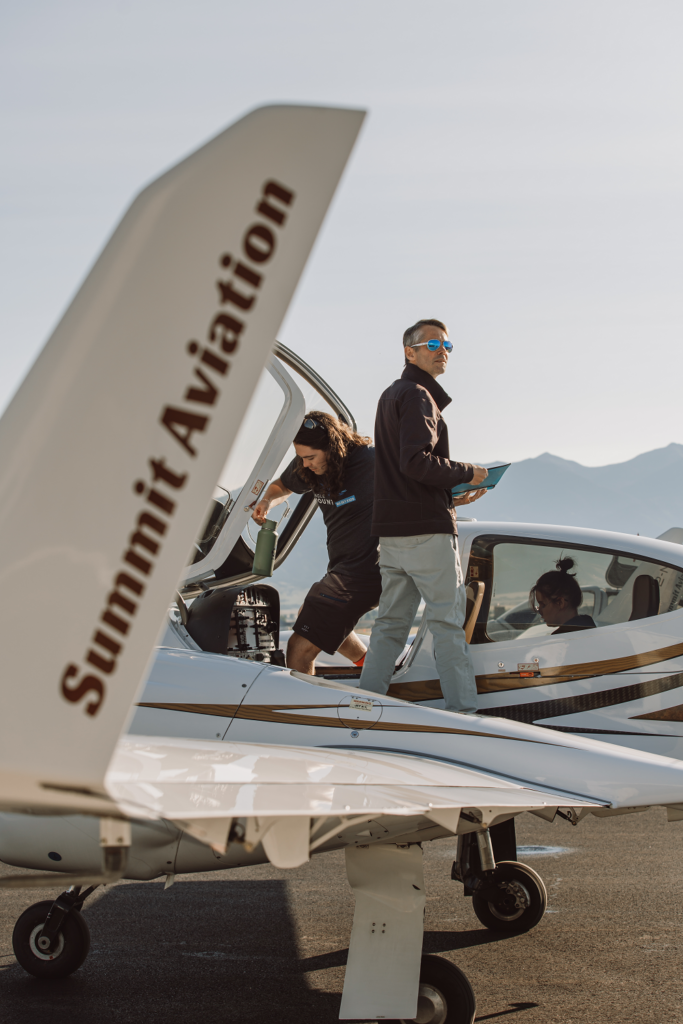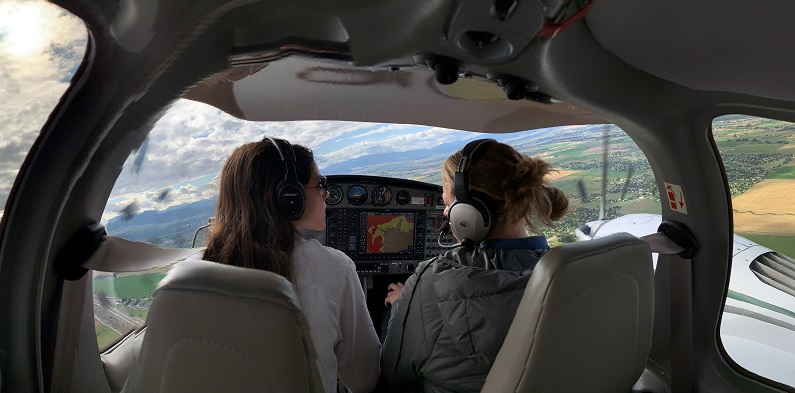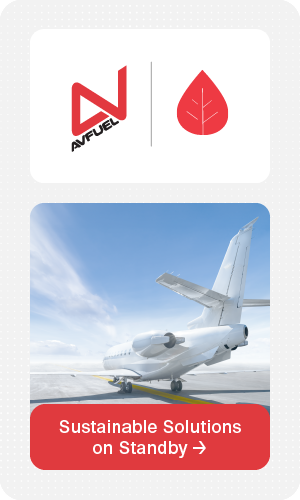Ben Walton, President of Summit Aviation in Montana, has spent his entire career thinking about and building a business around one central question: How can the general aviation industry recruit, educate, train, develop, and promote the next generation of skilled pilots and other employees to make FBOs and the industry as a whole more sustainable?
The answer he has been working on at Summit Aviation is a nearly closed-loop workforce pipeline where today’s flight school students become tomorrow’s Certified Flight Instructors while building hours to become the charter captains and co-captains of the future.
“I don’t think we, as an industry, do such a great job of educating young pilots or pilots-in-training about our side of the industry,” Walton says, identifying one of the core problems at the heart of industry-wide workforce shortages, including pilots. “I’ve met so many students who are in pilot training at some of the bigger aviation schools, who, when I ask them what they want to do in the industry, they say without pause, ‘Fly for the airlines.’ I’ll ask them, ‘Have you ever looked at corporate aviation, charter, or general aviation?’ And it usually turns out they know nothing about these segments.”
Industry consolidation on the airline side has not helped.
“At most of these universities, either the airlines own the flight schools, or they have agreements to create a direct pipeline from the universities to the airlines, so university stakeholders aren’t invested in telling our story for us,” Walton says. “If a student wants to go to the airlines, that’s great–there are certainly pluses and minuses to both sides of the industry–but if their reason for going to the airlines is that they aren’t aware of the opportunities available from the aviation business side of the industry, that’s sad to me. They don’t even know it’s an option and they didn’t have a straight path towards careers in this segment mapped out for them. We must work together as NATA members to address that.”
Walton has a unique perspective on building, maintaining, and growing a critical workforce pipeline infrastructure in the general aviation industry, based on his experience growing Summit Aviation from a single rented airplane and rented office 23 years ago at Bozeman Yellowstone International Airport (BZN) into a thriving, ever-expanding–charter operation.
His team of flight instructors and charter pilots is almost entirely alumni from Summit’s own award-winning Part 141 and Part 61 flight school.
“We’ve had a good, solid pipeline since the beginning, because the company started off as a flight school,” Walton says. “I think there are a lot of things worth sharing about our experience and our own pipeline, as NATA and its members work to address things like the pilot shortage and building a stronger workforce pipeline in general aviation as a whole.”
To help understand more about how that pipeline works, and its history, the Aviation Business Journal caught up with Walton for more on Summit Aviation’s story.
“The company started with just me: I moved to Bozeman about 23 years ago, and I just fell in love with the place,” Walton says. “It’s a great town, a great place to live, with a great college–it seemed like an ideal place to set up as a flight instructor. I went to the airport and met somebody with a little Cessna 150 and talked him into letting me lease it for flight lessons, rented an office for $50 a month from a local mechanic, posted fliers around town, and started to teach people how to fly airplanes out of Bozeman.”
He also taught introduction to aviation night classes at Gallatin College Montana State University to help make ends meet in those early years, with the course quickly becoming popular with students.
“I would have 20-30 students the first few years, then it grew to 60 students, so I wrote up a proposal for a full program in the early 2000s and, long story short, we launched a two-year aviation program in the 2005-2006 school year. So, it’s been about 18 years of building this college program from the ground up, developing curriculum, and it’s really evolved to be an amazing two-year degree program,” Walton says. “Students go from zero experience to Certified Flight Instructor in two years, and the curriculum is unique as it is not off-the-shelf and was developed in-house. We do mountain flying as part of the training and it’s robust and customized based on our philosophy of teaching. We now have around 100-120 students in the program.”
Walton no longer has to rely on posting a lot of fliers around town now the word is officially out. He says Gallatin College Montana State University planned to bring in 70 new students in the program for the coming 2023-2024 school year and has received about 300 applications.
“There’s demand for it now, so we’re able to be selective,” he says.
Walton says he takes the concept of a “workforce pipeline” both seriously, literally, and, yes, selfishly.
“As we’ve built this training program and trained all these pilots over the last 20-some years, we’ve been fortunate to be able to hire from within our own pipeline throughout this whole process,” he says. “All of our CFIs and a high percentage of our co-pilots and captains–an extremely high percentage–come up through our program.”
That’s by design.
“We’re training these students from day one to end up working for us, assuming they make that cut,” Walton says, “After two years, they graduate, become CFIs, and we pick the best CFIs out of the group to come work for us as our flight instructors. It’s really a two-year job interview. We’re watching them throughout their training, always thinking, ‘Who do we want to hire to be the next CFIs?’ Then it’s about a two-to-three-year process as a CFI, building hours, and we treat that time period as a job interview for our charter program–‘Are they part of our culture? Do they work hard? Are they going to be a good fit?–and then we pick the best CFIs to then move up to be co-pilots on our Phenom 300E aircraft, and now, 5 or 6 years in all told, they’re in the right seat, flying charter. And once they get enough hours in the right seat, they move to the left seat and go from there.”
Walton loves getting to see that entire trajectory unfold for his students-turned-employees.
“It’s awesome to watch these young pilots,” he says. “They start off at 17 or 18 years old, and by the time they’re in their early to mid-20s they’re captains on jets with really good jobs, good schedules, and an appreciation for being part of the program.”
Another important reward of overseeing his own workforce pipeline? “Quality control,” Walton says.
“It’s not just about the numbers of students coming through the pipeline: without the flight school we would have a really difficult time not only with finding pilots but also with pipeline quality,” he explains. “Nothing beats being able to know exactly what you have in an employee: we’ve known somebody for five years before they’re sitting in the right seat in the airplane. By then they already know who we are as a company, how we operate, and what the safety protocols are–they’re already part of the team. It’s a massive advantage over just hiring somebody off the street to go sit right seat in your plane, where you just don’t know what you’re going to get–having control of that whole pipeline has been huge.”
That pipeline has been garnering a lot of attention–and awards–in the industry, including the Aircraft Owners and Pilots Association (AOPA) Distinguished Flight School Award in both 2022 and 2023.
In 2022, AOPA also awarded its Distinguished Flight Instructor Award to Summit’s Chief Instructor, Missy Harlow. She is, naturally, a former student of the flight school: she graduated with an Associate of Applied Science in Aviation from Gallatin College Montana State University in 2017.
At this fall’s Aviation Business Conference, Walton says he hopes to help other NATA members–and the general aviation industry as a whole–find new ways to reach pilots early in their flight training journey before they have committed to flying for the airlines.
“One of the things we’ve learned, even with full partnership from both the college and the university, is that there definitely is competition from the airlines,” Walton says. “The airlines will send representatives into the school to give their pitch and will do things like come in right away and say to first-year students, ‘We’ll give you a bunch of money for your training if you commit to us.’ That’s a compelling reason to go to the airlines. For us, we want the students to want to be part of our company and work for it and earn it. It’s not just, ‘Hey, let’s just take who we can get and offer to pay for their training and hold them hostage by saying they have to pay us back if they’re going to do something else.’ I want to have something that’s unique, different, exciting, and compelling in its own way to offer these students, by showing them the path to rise through the ranks and what it means to be part of a great company and culture.”
In April 2023, Walton and his team broke ground on a new complex at Bozeman Yellowstone International Airport (BZN), set to open in 2024, that will serve as Summit Aviation’s headquarters, the new home of the flight school, and the home of its Annual Cancer Survivor Flight Camp. In July 2023, Summit Aviation celebrates the 9th anniversary of the Flight Camp, a partnership with Eagle Mount’s Big Sky Kids program.
Walton says the new headquarters–including 14,500 square feet for the flight school, office space, and a new departure lounge for charter customers, plus an additional 37,225 square feet of hangar space to house flight simulators, the training aircraft fleet, and the charter aircraft fleet–is the result of more than a decade of planning for the future. The future is now.
“I’m really grateful to have found out early in my career that I enjoy teaching people how to fly,” Walton says. “I just fell in love with that process. It’s a journey and to be part of someone’s journey is so much fun! It’s taking somebody who has never seen a small aircraft from just walking up to an airport to teaching them how to fly and then guiding them throughout their career path.”
Walton says that one thing all NATA members can agree on is that lots of business aviation and general aviation careers can be extremely rewarding.
“The next step is figuring out how we as an industry can do a better job of presenting general aviation as an option to all these students who are in training, in the same way that the airlines do, and better communicate what we can offer” Watson says.
So, what is the offer?
“Here in Montana, I’m proud to be able to say I can go into the school and tell students, ‘We can take you all the way from here to retirement. You do a good job and you can be a flight instructor for us. You do a really good job and you can fly our charter jets. You do a really, really good job and we have arrangements with other large companies and companies with flight departments that will guarantee you an interview and you can transition to flying their Gulfstream or larger aircraft that you can grow up with and retire in.’ There’s a lot of options in general aviation and we want to help them have a path that takes them all the way until they retire and gives them a solid career in this business along the way. That’s my main goal.”
Walton says one of his most important messages to other NATA members is that it is never too early to start making that pitch.
“For starters, we do a lot of things here at Summit with elementary school students, middle school students, and high school students to get people exposed to aviation and to the rewarding careers in general aviation as early as possible,” Walton says. “It seems like there’s always a tour going on here! I wish we could measure how many of those people end up coming through the college program, but we know for a fact that some of them do. I’ll just say this: there’s a lot of new pilots from our area who are training with us right now. It’s the best time in the world to become a pilot, and a lot of kids around here know that and are doing it. We need to keep working to capture more of that top talent.”
Ben Walton will be a panelist at the workforce session on November 2, 2023, during the NATA Aviation Business Conference in Long Beach, California.

By Colin Bane






